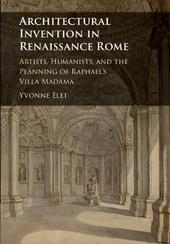
|
Architectural Invention in Renaissance Rome: Artists, Humanists, and the Planning of Raphael's Villa Madama
Hardback
Main Details
| Title |
Architectural Invention in Renaissance Rome: Artists, Humanists, and the Planning of Raphael's Villa Madama
|
| Authors and Contributors |
By (author) Yvonne Elet
|
| Physical Properties |
| Format:Hardback | | Pages:360 | | Dimensions(mm): Height 261,Width 184 |
|
| Category/Genre | Residential buildings and domestic buildings
History of architecture
Literary studies - classical, early and medieval |
|---|
| ISBN/Barcode |
9781107130524
|
| Classifications | Dewey:720.94509031 |
|---|
| Audience | | Postgraduate, Research & Scholarly | |
|---|
| Illustrations |
19 Plates, color; 97 Halftones, black and white; 1 Line drawings, black and white
|
|
Publishing Details |
| Publisher |
Cambridge University Press
|
| Imprint |
Cambridge University Press
|
| Publication Date |
11 January 2018 |
| Publication Country |
United Kingdom
|
Description
Villa Madama, Raphael's late masterwork of architecture, landscape, and decoration for the Medici popes, is a paradigm of the Renaissance villa. The creation of this important, unfinished complex provides a remarkable case study for the nature of architectural invention. Drawing on little known poetry describing the villa while it was on the drawing board, as well as ground plans, letters, and antiquities once installed there, Yvonne Elet reveals the design process to have been a dynamic, collaborative effort involving humanists as well as architects. She explores design as a self-reflexive process, and the dialectic of text and architectural form, illuminating the relation of word and image in Renaissance architectural practice. Her revisionist account of architectural design as a process engaging different systems of knowledge, visual and verbal, has important implications for the relation of architecture and language, meaning in architecture, and the translation of idea into form.
Author Biography
Yvonne Elet is Associate Professor of Art History at Vassar College, New York. A specialist in Italian early modern art and architecture, her research focuses on Renaissance villa culture; integrated designs for art, architecture, and landscape; early modern stucco; and intersections among art, literature, science, and natural philosophy. Her articles appear in the Journal of the Society of Architectural Historians and I Tatti Studies in the Italian Renaissance. She has received grants from the Center for Advanced Studies in the Visual Arts, the Getty Research Institute, and the American Council of Learned Societies. She has also been a Fellow at the Metropolitan Metropolitan Museum of Art and at the Frick Collection, New York, as well as a visiting scholar at the Max-Planck-Institut fur Wissenschaftsgeschichte, Berlin.
Reviews'... what this book does splendidly is focus our attention on the roles of people other than patrons and architects - the advisers, many unnamed - in the production of architecture. In addition, it makes a fundamental contribution by asserting that the poetry associated with villas deserves to be considered as a key part of the process of those villas' designs.' Paul Davies, Journal of the Society of Architectural Historians 'This substantial, original book makes significant contributions to our understanding of the architectural design process in early modern Rome ... [Elet] moves effortlessly across traditional disciplinary boundaries, deftly interweaving different modes of analysis and a profound familiarity with myriad sources, primary and secondary ... The book's production value matches the quality of its concept and writing, with many well-chosen illustrations that evoke both the villa and the ideas in circulation around it quite nicely.' Jessica Maier, Renaissance Quarterly
|